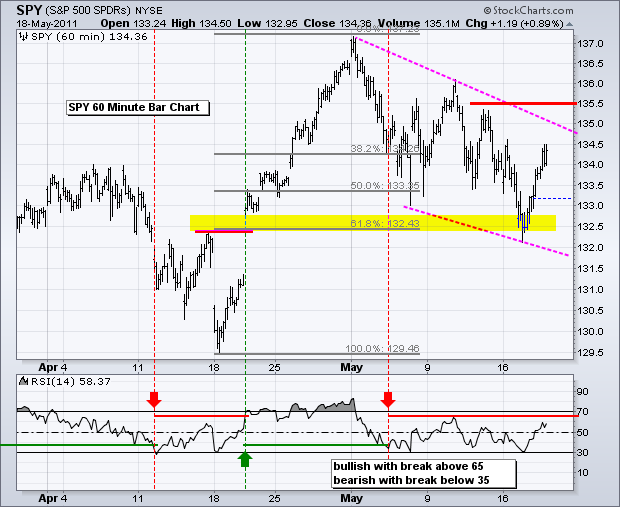Looking the daily chart for SPY, I am struck by the fact that 14-day RSI did not reach overbought levels in late April or early May. The surge from the mid March low to the early May high was quite strong. SPY advanced over 8% in 6-7 weeks. Despite such a strong move, RSI did not exceed 70. Notice how RSI moved above 70 numerous times from late December to late February. Wells Wilder, the creator of RSI, would call this a bearish failure swing. It is also a bearish divergence because SPY forged a higher high and RSI did not. I ignore most bearish divergences, but this one may be different because of the failure swing. RSI is currently testing support in the 40-50 zone. A break below this support zone would turn momentum bearish.


Key Economic Reports/Events:
Wed - May 18 - 07:00 - MBA Mortgage Index
Wed - May 18 - 10:30 - Oil Inventories
Wed - May 18 - 14:00 - FOMC Minutes
Thu - May 19 - 08:30 - Jobless Claims
Thu - May 19 - 10:00 - Existing Home Sales
Thu - May 19 - 10:00 - Philadelphia Fed
Thu - May 19 - 10:00 - Leading Indicators
Charts of Interest: Tuesday and Thursday in separate post.
***********************************************
This commentary and charts-of-interest are designed to stimulate thinking. This analysis is not a recommendation to buy, sell, hold or sell short any security (stock ETF or otherwise). We all need to think for ourselves when it comes to trading our own accounts. First, it is the only way to really learn. Second, we are the only ones responsible for our decisions. Think of these charts as food for further analysis. Before making a trade, it is important to have a plan. Plan the trade and trade the plan. Among other things, this includes setting a trigger level, a target area and a stop-loss level. It is also important to plan for three possible price movements: advance, decline or sideways. Have a plan for all three scenarios BEFORE making the trade. Consider possible holding times. And finally, look at overall market conditions and sector/industry performance.






